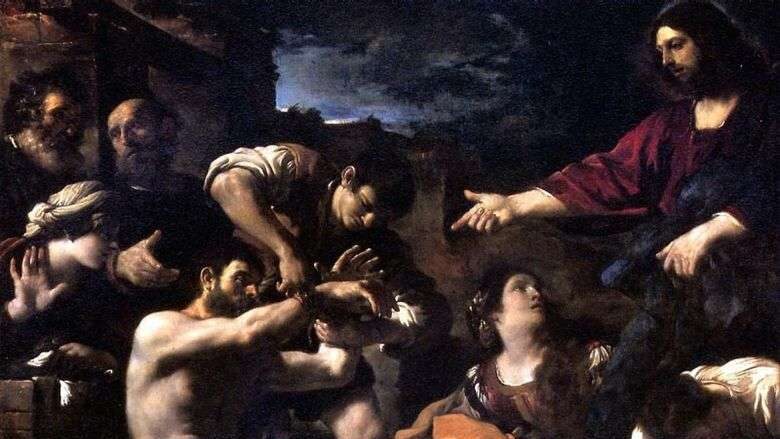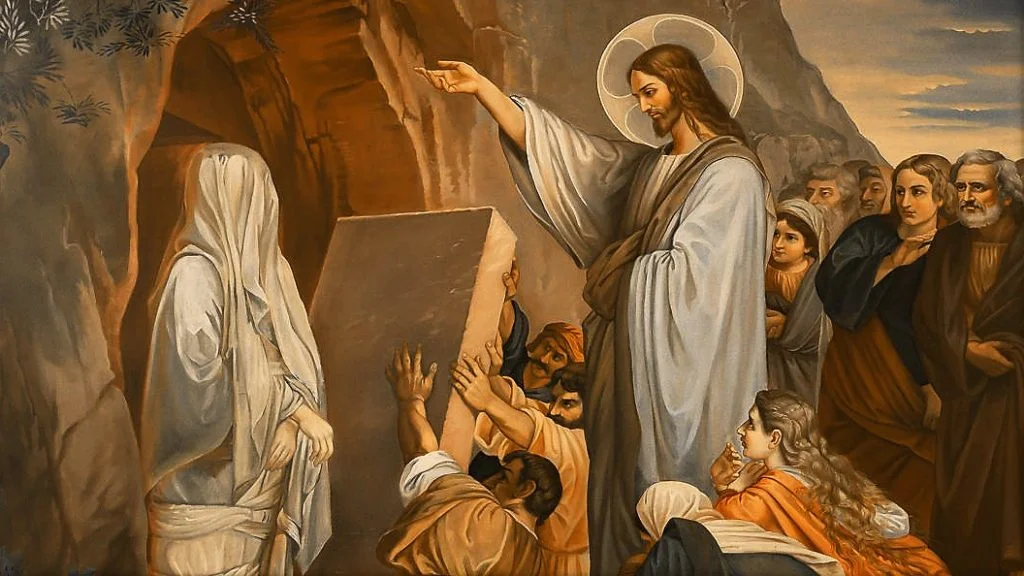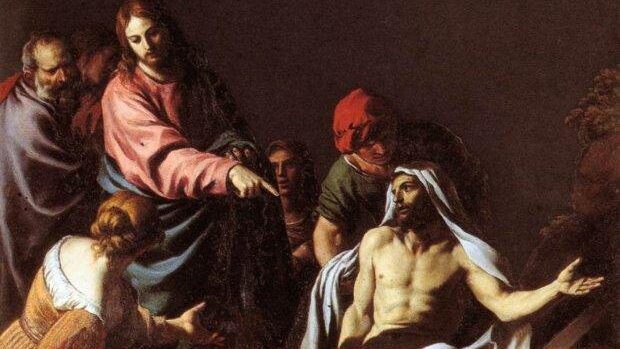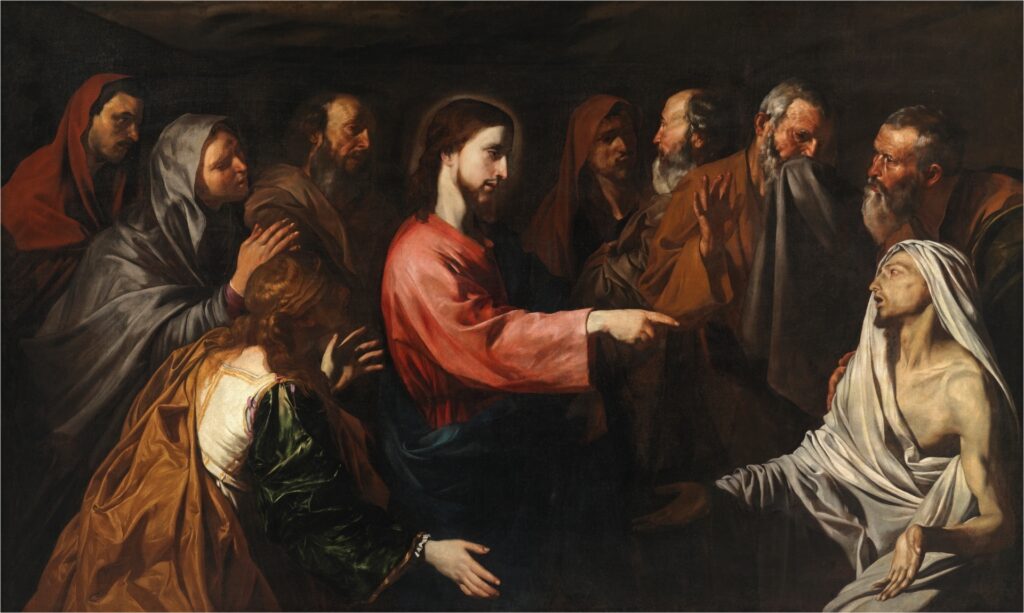POPE FRANCIS ON THE 5TH SUNDAY OF LENT A

ANGELUS
Saint Peter’s Square
5th Sunday of Lent A, 26 March 2023
______________________________________
Dear brothers and sisters, buongiorno!
Today, fifth Sunday of Lent, the Gospel presents to us the resurrection of Lazarus (cf. Jn 11:1-45). It is the last of Jesus’ miracles narrated before Easter: the resurrection of his friend Lazarus. Lazarus is a dear friend of Jesus, who knows he is about to die; he sets out on his journey, but arrives at his house four days after the burial, when by now all hope is lost. His presence, however, rekindles a little confidence in the hearts of the sisters Martha and Mary (cf. vv. 22, 27). They cling to this light, to this small hope, despite their suffering. Jesus invites them to have faith, and asks for the tomb to be opened. He then prays to the Father and shouts to Lazarus: “Come out!” (v. 43). And the latter comes back to life and comes out. This is the miracle, just like that, simple.
The message is clear: Jesus gives life even when it seems that all hope has gone. It happens, at times, to feel hopeless – this has happened to us all – or to meet people who have given up hope: embittered by bad experiences, the wounded heart cannot hope. Because of a painful loss, an illness, a bitter disappointment, a wrong or a betrayal suffered, a grave error committed… they have given up hope. At times we hear those who say that “There is nothing more to be done!”, and close the door to every hope. They are moments when life seems to be a sealed tomb: everything is dark, and around us we see only sorrow and despair. Today’s miracle tells us that it is not like that, this is not the end, that in these moments we are not alone; on the contrary, it is precisely in these moments that He comes closer than ever to restore life to us. Jesus weeps: the Gospel tells us that Jesus wept in front of Lazarus’ tomb, and today Jesus weeps with us, as he was able to weep for Lazarus: the Gospel repeats twice that he is moved (cf. vv. 33, 38), emphasizes that he burst into tears (cf. v. 35). And at the same time Jesus invite us not to stop believing and hoping, not to let ourselves be crushed by negative feelings, which take away our tears. He approaches our tombs and says to us, as then: “Take away the stone” (v. 39). In these moments, it is as though we have a stone inside, and the only one capable of removing it is Jesus, with his word: “Take away the stone”.
Jesus says this to us too. Take away the stone: the pain, the mistakes, even the failures, do not hide them inside you, in a dark, lonely, closed room. Take away the stone: draw out everything that is inside. “Ah, but I am ashamed”. Throw it to me with confidence, says the Lord, I will not be outraged; throw it to me without fear, because I am with you, I care about you and I want you to start living again. And, as he did with Lazarus, he repeats to each one of us: Come out! Rise again, get back on the path, regain your confidence! How many times, in life, we find ourselves like this, in this situation of no longer having the strength to get up again. And Jesus: “Go, go on! I am with you”. I will take you by the hand, says Jesus, like when you were a child learning to take your first steps. Dear brother, dear sister, take off the bandages that bind you (cf. v. 45); please, do not give in to the pessimism that depresses you, do not give in to the fear that isolates, do not give in to the discouragement caused by the memory of bad experiences, do not give in to the fear that paralyses. Jesus tells us, “I want you free and alive, I will not abandon you and I am with you! Everything is dark, but I am with you! Do not let yourself be imprisoned by pain, do not let hope die. Brother, sister, come back to life!”. “And how can I do this?”. “Take my hand”, and he takes us by the hand. Let you be pulled out: and he is capable of doing it. In these bad moments that happen to us all.
Dear brothers and sisters, this passage, in chapter 11 of the Gospel of John and which it does a great deal of good to read, is a hymn to life, and it is proclaimed when Easter is near. Perhaps we too in this moment carry in our heart some burden or some suffering, that seems to crush us; something bad, some old sin we cannot bring out, some youthful mistake, you never know. These bad things need to come out. And Jesus says, “Come out!”. So, it is the moment to take away the stone and to go out towards Jesus, who is close. Can we open our hearts to him and entrust our worries to him? Shall we do it? Are we able to open the tomb of problems, are we capable, and look over the threshold, towards his light, or are we afraid of this? And in turn, as small mirrors of God’s love, do we manage to illuminate the environments in which we live with words and gestures of life? Do we bear witness to the hope and joy of Jesus? We, sinners, all of us? And also, I would like to say a word to confessors: dear brothers, do not forget that you too are sinners, and you are in the confessional not to torture, but to forgive, and to forgive everything, just as the Lord forgives everything. May Mary, Mother of Hope, renew in us the joy of not feeling alone and the call to bring light into the darkness that surrounds us.
Source: https://www.vatican.va/content/francesco/en/angelus/2023/documents/20230326-angelus.html
EMPHASIS ADDED

ANGELUS
Library of the Apostolic Palace
5TH SUNDAY OF LENT A, 29 March 2020
Dear Brothers and Sisters, Good Morning,
The Gospel passage for this fifth Sunday of Lent is the resurrection of Lazarus (cf. Jn 11:1-45). Lazarus was Martha and Mary’s brother; they were good friends of Jesus. When Jesus arrives in Bethany, Lazarus has already been dead for four days. Martha runs towards the Master and says to Him: “If you had been here, my brother would not have died!” (v. 21). Jesus replies to her: “Your brother will rise again” (v. 23) and adds: “I am the resurrection and the life; he who believes in me, though he die, yet shall he live” (v. 25). Jesus makes himself seen as the Lord of life, he who is capable of giving life even to the dead. Then Mary and other people arrive, in tears, and so Jesus — the Gospel says — “was deeply moved in spirit and troubled…. Jesus wept” (vv. 33, 35). With this turmoil in his heart, he goes to the tomb, thanks the Father who always listens to him, has the tomb opened and cries aloud: “Lazarus, come out!” (v. 43). And Lazarus emerges with “his hands and feet bound with bandages and his face wrapped with a cloth” (v. 44).
Here we can experience first hand that God is life and gives life, yet takes on the tragedy of death. Jesus could have avoided the death of his friend Lazarus, but he wanted to share in our suffering for the death of people dear to us, and above all, he wished to demonstrate God’s dominion over death. In this Gospel passage we see that the faith of man and the omnipotence of God, of God’s love, seek each other and finally meet. It is like a two-lane street: the faith of man and the omnipotence of God’s love seek each other and finally meet. We see this in the cry of Martha and Mary, and of all of us with them: “If you had been here!”. And God’s answer is not a speech, no, God’s answer to the problem of death is Jesus: “I am the resurrection and the life” … have faith. Amid grief, continue to have faith, even when it seems that death has won. Take away the stone from your heart! Let the Word of God restore life where there is death.
Today, too, Jesus repeats to us: “Take away the stone”. God did not create us for the tomb, but rather he created us for life, [which is] beautiful, good, joyful. But “through the devil’s envy death entered the world” (Wis 2:24) says the Book of Wisdom, and Jesus Christ came to free us from its bonds.
We are thus called to take away the stones of all that suggests death: for example, the hypocrisy with which faith is lived, is death; the destructive criticism of others, is death; insults, slander, are death; the marginalization of the poor, is death. The Lord asks us to remove these stones from our hearts, and life will then flourish again around us. Christ lives, and those who welcome him and follow him come into contact with life. Without Christ, or outside of Christ, not only is life not present, but one falls back into death.
The resurrection of Lazarus is also a sign of the regeneration that occurs in the believer through Baptism, with full integration within the Paschal Mystery of Christ. Through the action and power of the Holy Spirit, the Christian is a person who journeys in life as a new creature: a creature for life, who goes towards life.
May the Virgin Mary help us to be compassionate like her son Jesus, who made our suffering his own. May each of us be close to those who are in difficulty, becoming for them a reflection of God’s love and tenderness, which frees us from death and makes life victorious.
EMPHASIS ADDED. Source: https://www.vatican.va/content/francesco/en/angelus/2020/documents/papa-francesco_angelus_20200329.html

HOMILY OF HIS HOLINESS POPE FRANCIS
Piazza Martiri (Carpi)
5th Sunday of Lent A, 2 April 2017
Today’s readings tell us of the God of life, who conquers death. Let us pause in particular on the last of the miraculous signs which Jesus performs before his Easter, at the sepulchre of his friend, Lazarus.
Everything appears to have ended there: the tomb is sealed by a great stone; there is only weeping and desolation there. Even Jesus is shaken by the dramatic mystery of the loss of a dear person: “He was deeply moved in spirit and troubled” (Jn 11:33). Then “Jesus wept” (v. 35) and went to the sepulchre, the Gospel says, “deeply moved again” (v. 38). This is God’s heart: far from evil but close to those who are suffering. He does not make evil disappear magically, but he endures the suffering; he makes it his own and transforms it; he abides it.
We notice, however, that amid the general despair over the death of Lazarus, Jesus does not allow himself to be transported by despair. Even while suffering himself, he asks that people believe steadfastly. He does not close himself within his weeping but, moved, he makes his way to the sepulchre. He does not allow the resigned, emotional atmosphere that surrounds him to seize him, but rather, prays with trust and says, “Father, I thank thee” (v. 41). Thus, in the mystery of suffering, before which thoughts and progress are crushed like flies against glass, Jesus offers us the example of how to conduct ourselves. He does not run away from suffering, which is part of this life, but he does not allow himself to be held captive by pessimism.
A great “encounter-clash” thus occurred at that sepulchre. On the one hand, there is the great disappointment, the precariousness of our mortal life which, pierced by anguish over death, often experiences defeat, an interior darkness which seems insurmountable. Our soul, created for life, suffers upon hearing that its thirst for eternal good is oppressed by an ancient and dark evil. On the one hand, there is this defeat of the sepulchre. But on the other, there is the hope that conquers death and evil, and which has a name: the name of hope is Jesus.
He neither brings a bit of comfort nor some remedy to prolong life, but rather, proclaims: “I am the Resurrection and the life; he who believes in me, though he die, yet shall he live”, (v. 25). It is for this reason that he says decisively, “Take away the stone” (v. 39) and he calls to Lazarus, “Come out” (v. 43).
Dear brothers and sisters, we too are called to decide on which side to stand. One can stand on the side of the sepulchre or on the side of Jesus. There are those who allow themselves to be closed within their pain and those who open up to hope. There are those who remain trapped among the ruins of life, and those who, like you, with God’s help, pick up the ruins of life and rebuild with patient hope.
In facing life’s great ‘whys?’, we have two paths: either stay and wistfully contemplate past and present sepulchres, or allow Jesus to approach our sepulchres. Yes, because each one of us already has a small sepulchre, some area that has somewhat died within our hearts; a wound, a wrongdoing endured or inflicted, an unrelenting resentment, a regret that keeps coming back, a sin we cannot overcome. Today, let us identify these little sepulchres that we have inside, and let us invite Jesus into them. It is curious, but we often prefer to be alone in the dark caves within us rather than invite Christ inside them. We are tempted to always seek [solutions for] ourselves, brooding and sinking into anguish, licking our wounds, instead of going to him, who says, “Come to me, all who labour and are heavy laden, and I will give you rest”, (Mt 11:28). Let us not be held captive by the temptation to remain alone and discouraged, crying about what is happening to us. Let us not give in to the useless and inconclusive logic of fear, resignedly repeating that everything is going badly and nothing is as it once was. This is the sepulchral atmosphere. The Lord instead wishes to open the path of life, that of encounter with him, of trust in him, of the resurrection of the heart, the way of: “Arise, Arise, come out”. This is what the Lord asks of us, and he is by our side to do so.
Thus, we hear directed to each one of us Jesus’ words to Lazarus: “Come out”. Come out from the gridlock of hopeless sadness; unwrap the bandages of fear that impede the journey, the laces of the weaknesses and anxieties that constrain you; reaffirm that God unties the knots. By following Jesus, we learn not to knot our lives around problems which become tangled. There will always be problems, always, and when we solve one, another one duly arrives. We can however, find a new stability, and this stability is Jesus himself. This stability is called Jesus, who is the Resurrection and the Life. With him, joy abides in our hearts, hope is reborn, suffering is transformed into peace, fear into trust, hardship into an offering of love. And even though burdens will not disappear, there will always be his uplifting hand, his encouraging Word saying to all of us, to each of us: “Come out! Come to me!”. He tells all of us: “Do not be afraid”.
Today, just like then, Jesus says to us to: “take away the stone”. However burdensome the past, great the sin, weighty the shame, let us never bar the Lord’s entrance. Let us, before him, remove that stone which prevents him from entering. This is the favourable time to remove our sin, our attachment to worldly vanity, the pride that blocks our souls, so much hostility among us, in families…. This is the favourable time for removing all these things.
Visited and liberated by Jesus, we ask for the grace to be witnesses of life in this world that thirsts for it, witnesses who spark and rekindle God’s hope in hearts weary and laden with sadness. Our message is the joy of the living Lord, who says again today, as he did to Ezekiel, “Behold, I will open your graves and raise you from your graves, O my people (Ez 37:12).
EMPHASIS ADDED. Source: https://www.vatican.va/content/francesco/en/homilies/2017/documents/papa-francesco_20170402_omelia-visitapastorale-carpi.html

ANGELUS
St. Peter’s Square
5th Sunday of Lent A, 6 April 2014
Dear Brothers and Sisters, Good morning!
The Gospel of this Fifth Sunday of Lent tells us of the resurrection of Lazarus. It is the culmination of the miraculous “signs” worked by Jesus: this act is too great, too clearly divine to be tolerated by the high priests, who, learning of the fact, decided to kill Jesus (cf. Jn 11:53).
Lazarus had already been dead four days, before Jesus arrived; and what he said to the sisters Martha and Mary is engraved forever in the memory of the Christian community. Jesus speaks like this: “I am the resurrection and the life; he who believes in me, though he die, yet shall he live, and whoever lives and believes in me shall never die” (Jn 11:25, 26). With this word of the Lord we believe that the life of whoever believes in Jesus and follows his Commandment after death will be transformed into new life, full and immortal. As Jesus is resurrected with his own body, though he does not return to an earthly life, so too will we be raised with our bodies which will have been transfigured into glorified bodies. He expects us with the Father, and by the power of the Holy Spirit, who raised him, he will also raise those who are united to him.
Before the sealed tomb of his friend Lazarus, Jesus “cried with a loud voice: ‘Lazarus, come out!’. And the dead man came out, his hands and feet bound with bandages, and his face wrapped with a cloth” (vv. 43-44). This cry is an imperative to all men, because we are all marked by death, all of us; it is the voice of the One who is master of life and wants that all we all may “have it abundantly” (Jn 10:10). Christ is not resigned to the tombs that we have built for ourselves with our choice for evil and death, with our errors, with out sins. He is not resigned to this! He invites us, almost orders us, to come out of the tomb in which our sins have buried us. He calls us insistently to come out of the darkness of that prison in which we are enclosed, content with a false, selfish and mediocre life. “Come out!”, he says to us, “Come out!”. It is an invitation to true freedom, to allow ourselves to be seized by these words of Jesus who repeats them to each one of us today. It is an invitation to let ourselves be freed from the “bandages”, from the bandages of pride. For pride makes of us slaves, slaves to ourselves, slaves to so many idols, so many things. Our resurrection begins here: when we decide to obey Jesus’ command by coming out into the light, into life; when the mask falls from our face — we are frequently masked by sin, the mask must fall off! — and we find again the courage of our original face, created in the image and likeness of God.
Jesus’ act of raising Lazarus shows the extent to which the power of God’s grace can go, and, thus, the extent of our conversion, our transformation. Listen carefully: there is no limit to the divine mercy offered to everyone! There is no limit to divine mercy which is offered to everyone! Remember this sentence. And we can all say it together: “there is no limit to divine mercy which is offered to all people!”. Let us say it together: “There is no limit to divine mercy which is offered to everyone!”. The Lord is always ready to remove the tombstone of our sins, which keeping us apart from him, the light of the living.
EMPHASIS ADDED. Source: https://www.vatican.va/content/francesco/en/angelus/2014/documents/papa-francesco_angelus_20140406.html
SEE AS WELL:
Stay updated: subscribe by email for free TO OUR NEW WEBSITE www.catholicsstrivingforholiness.org (PUT YOUR EMAIL IN THE SUBSCRIBE WIDGET).
We are also in www.fb.com/Catholicsstrivingforholiness. Kindly help more people in their Christian life by liking our page and inviting your family, friends and relatives to do so as well. Thanks in advance and God bless you and your loved ones! Fr. Rolly Arjonillo